The Brazos Performance Preview: AMD E-350 Benchmarked
by Anand Lal Shimpi on November 16, 2010 12:01 AM ESTMemory and Cache Latencies
The Brazos platform was configured with 4GB of DDR3-1066 memory. The IDF system had memory running at DDR3-1333, however AMD had to decrease clocks presumably to meet validation requirements for final silicon. I measured an 86.9ns trip to main memory, a 3 cycle L1 and a ~22 cycle L2 cache. That's a lower latency memory interface than Atom or Core 2 based processors, but a higher latency L2.
CPU Performance: Better than Atom, 90% of K8 but Slower than Pentium DC
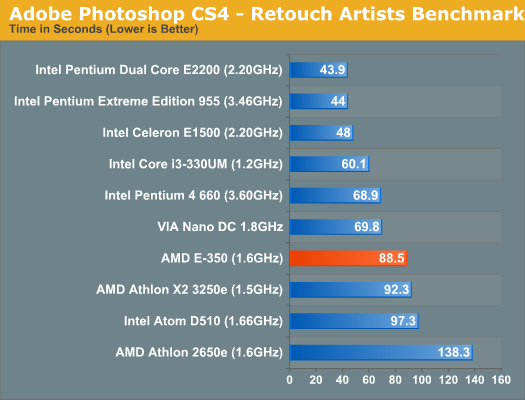
AMD's performance target for Bobcat was 90% of the performance of K8 at the same clock speed and our Photoshop CS4 benchmark shows that AMD can definitely say that it has met that goal. At 1.6GHz the E-350 manages to outperform a pair of K8s running at 1.5GHz in the Athlon X2 3250e. Unfortunately for AMD, Intel's Pentium dual-core running at 2.2GHz is much quicker. Most notebooks in the $400+ range have at least a 2.2GHz Pentium. Even the Atom D510 isn't far behind.
AMD tells me that in general purpose integer tasks, the E-350 should do well and it may even exceed AMD's 90% design target. However in higher IPC workloads, for example many floating point workloads, the E-350 is constrained by its dual issue front end. In these situations, the out of order engine is starved for instructions and much of Bobcat's advantage goes away.

Our x264 HD test has the E-350 performing within 86 - 92% of the Athlon X2 3250e, once again meeting AMD's design targets. Unfortunately, this isn't much faster than an Atom - mostly thanks to Atom's Hyper Threading support. Although not an out of order architecture, Atom gets a healthy efficiency boost by being able to execute instructions from two threads per core. Once again, compared to a 2.2GHz Pentium, the E-350 isn't close. Even VIA's dual core Nano is faster. When it comes to power consumption however, the E-350 can't be touched. I measured max system power consumption at 25.2W while running the x264 encode test. With the exception of the Atom D510, the rest of the desktop platforms here consume much more than that at idle (much less under load).
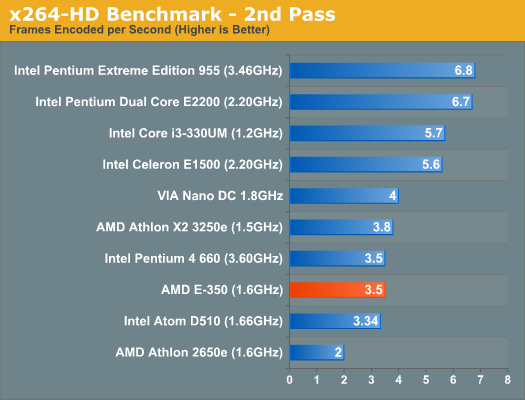
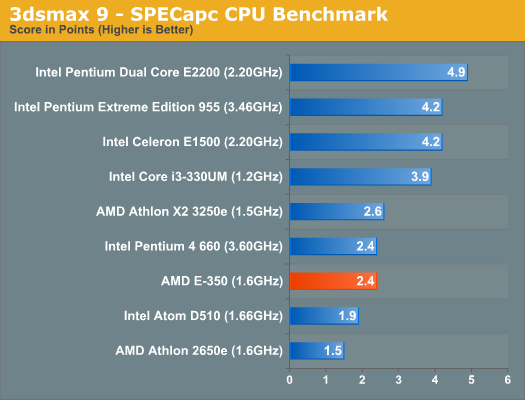
Despite being a offline 3D rendering benchmark, our 3dsmax 9 test does fall in line with expectations. The E-350 delivers 92% of the performance of the Athlon X2 3250e and outperforms the Atom D510 by 26%. Unfortunately for AMD, the Pentium dual-core holds onto a significant performance advantage here. Clock for clock, Bobcat won't be able to do much against anything Core 2 based. The real advantage here will be GPU performance.
Single Threaded Performance
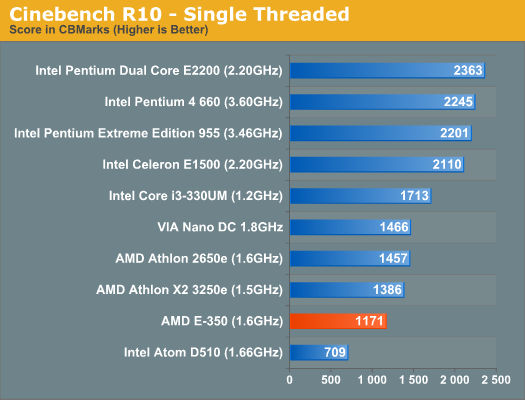
In most of our benchmarks the performance advantage over Atom isn't huge, yet using Brazos is much better than using an Atom based machine. It all boils down to one thing: single threaded performance. Atom can make up for its deficiencies by executing a lot of threads in parallel, but when you're bound by the performance of a single thread the E-350 shines. The E-350 is 65% faster than the Atom D510 in the single threaded Cinebench R10 test. It's this performance advantage that makes the E-350 feel so much quicker than Atom.
The Core i3-330UM manages a 46% performance advantage over the E-350. Even in the ultraportable Arrandale ULV space at lower clocks, AMD still leaves a lot of CPU performance on the table. The advantage here will be cost. A single E-350 is less than 40% of the die area of a Core i3-330UM. You may not get the same CPU performance, but performance per mm^2 is much higher.

In the multithreaded Cinebench test Atom is able to catch up quite a bit, but the E-350 still holds an 11% advantage.
File Compression/Archive Recovery Performance
Our final two CPU tests are both multithreaded and they show the E-350 equaling and falling behind the performance of the 1.5GHz Athlon X2. As we explained earlier, the gap between the E-350 and Atom shrinks as you add more threads to the workload.
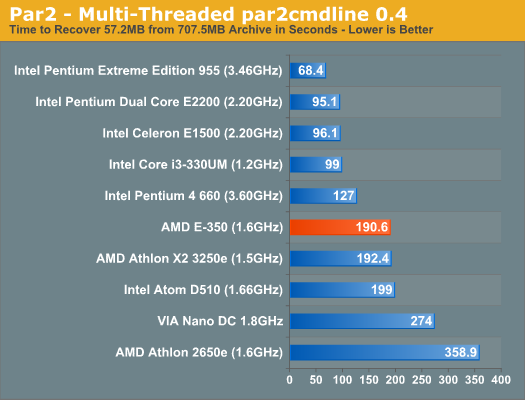
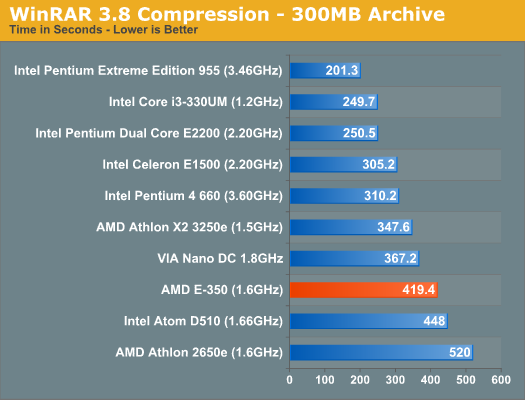










207 Comments
View All Comments
jdonkey123 - Tuesday, November 16, 2010 - link
What are the primary processor-related factors for consumers buying a new mobile PC?Battery Life, Price, Form Factor, & Performance (perceived)
When you look at these factors, it's pretty obvious that this platform fits into a large hole between high-end Atom based offerings and Intel's myriad ULV and non-ULV mobile parts.
While much of that is obvious from this excellent benchmarks article, what's missing a bit is a compilation of relative power consumption (and by extension, battery life.)
The most power-hungry Atom system that this is likely to compete against in mobile can be found in the Asus Eee PC 1015PN with a DC Atom N550 + NG-ion. CNet found load power of that system to be 20.66 watts. Compare that to the E-350's 25 watts that you found under similar load (assuming gaming wasn't CNet's test case.)
In that case, the power consumption is only modestly higher for what seems like at least an equivalent boost in performance and at $429 list, AMD's system looks pretty good!
I guess I see an upgraded slate of netbooks as the most likely home for this APU and I think that as long as the pricing is there, AMD is actually in a great position to displace a ton of the higher-end Atom parts.
Ref: http://reviews.cnet.com/laptops/asus-eee-pc-1015pn...
Joe Supersales - Tuesday, November 16, 2010 - link
If you want to test one please contact Joe Jao at www.jetwaycomputer.com, Tel: 510-857-0130 Ext# 128, thanks.gudodayn - Tuesday, November 16, 2010 - link
With all the noises Intel and AMD makes, I am surprised at the little guy's performance figures, the VIA Nano DC.I read the VIA Nano DC review and knew it took out Intel Atom D510 with ease but in the larger picture with desktop CPU numbers, I didn't expect it to do what it did!!!
I am excited about consumer products developed for the VIA Nano DC but unfortunately past experiences tell us all that in the market today, its all gobbled up by other bigger players!!!
Iketh - Wednesday, November 17, 2010 - link
you're forgetting Nano's power consumption...this is everyone's argument proven in many of these posts, the article was written in the wrong light for Brazos... people looking at $500 notebooks either want near-desktop performance and dont care about 6 hour battery life, or they need a spreadsheet/web surfer with 6+ hours of battery... these are NOT competing markets
this is one instance where sticking to the price bracket does not work
sprockkets - Tuesday, November 16, 2010 - link
What about the performace of this vs. the current Zotac Ion board with the Intel SU3200 dual core chip at 1.2ghz?Dark_Archonis - Tuesday, November 16, 2010 - link
Irrelevant comparison. Intel's "i" processors offer strong performance for those who want it. For those who can't afford the performance, lower CPUs are "good enough".I'd love to hear why you think AMD settled for "good enough" in terms of Bobcat performance.
Atom will get smaller and less power hungry than Bobcat. i3 and above CPUs offer easily better performance than Bobcat. A Celeron E in many cases offer better-than-Bobcat CPU performance. Bobcat's GPU is not good enough for gaming or intensive multimedia tasks.
Bobcat ends up being stuck in no-mans land.
Clearly this discussion is about Bobcat. So tell me, what is the point of Bobcat compared to Atom? Sure it's faster than Atom, but it's still not fast enough to make a big impact in the market.
Dark_Archonis - Tuesday, November 16, 2010 - link
Yes they have a long way to go, but Intel's upcoming Atom SoC designs dramatically reduce power consumption. Cedar Trail and Oak Trail are supposed to be very power efficient Atom platforms.So Zacate is mainly good for GPU-accelerated browsing? What about when Intel offers a strong-enough GPU integrated with Atom for hardware accelerated browsing? What then?
Dark_Archonis - Tuesday, November 16, 2010 - link
Better get your wings ready then. Cedar Trail and Oak Trail will offer far lower Atom platform power consumption than current Atom platforms. Don't believe me? You'll see when the products are released, don't take my word for it.Really, "at the same price"? For the price that Zacate will go for, I'm pretty sure I would be able to get a Celeron E or Core 2 Duo-based Pentium for about the same price. Yes in some games they would perform worse due to the IGP in those products, but gaming on Zacate is a struggle anyways so it would be a moot point.
As for average everyday tasks, a Celeron E or Pentium would generally perform better than Bobcat.
You get what you pay for. Lower end products have lower end performance. This is a simple fact, no need to get politically correct.
Anyone who wants performance wouldn't be looking at this market anyways. Neither Atom nor Bobcat provide enough performance for enthusiast/performance users.
Dark_Archonis - Tuesday, November 16, 2010 - link
No, I don't "speculate much", do you?Do you want me to post links to what Intel has said about the future of Atom, or should I let you look it up yourself?
Intel itself has talked about how Atom will get smaller and lower in power consumption while keeping the same performance or better.
Iketh - Wednesday, November 17, 2010 - link
"dark_archonis", just stop... you're making a complete fool of yourselfanand need's DT's post rating scheme please